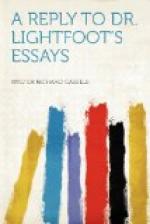“The reader is naturally led to think that a writer would not use such very decided language unless he had obtained a thorough mastery of his subject; and when he finds the notes thronged with references to the most recondite sources of information, he at once credits the author with an ‘exhaustive’ knowledge of the literature bearing upon it. It becomes important therefore to enquire whether the writer shows that accurate acquaintance with the subject, which justifies us in attaching weight to his dicta as distinguished from his arguments.” [59:1]
This sentence shows the scope of the discussion. My dicta, however, play a very subordinate part throughout, and even if no weight be attached to them—and I have never desired that any should be—my argument would not be in the least degree affected.
The first point attacked, like most of those subsequently assailed, is one of mere critical history. I wrote: “The strongest internal, as well as other evidence, into which space forbids our going in detail, has led (1) the majority of critics to recognize the Syriac version as the most genuine form of the letters of Ignatius extant, and (2) this is admitted by most of those who nevertheless deny the authenticity of any of the epistles.” [59:2]
Upon this Dr. Lightfoot remarks:—
“No statement could
be more erroneous as a summary of the results
of the Ignatian controversy
since the publication of the Syriac
epistles than this.”
[59:1]
It will be admitted that this is pretty “decided language” for one who is preaching “diffidence.” When we come to details, however, Dr. Lightfoot admits: “Those who maintain the genuineness of the Ignatian Epistles in one or other of the two forms, may be said to be almost evenly divided on this question of priority.” He seems to consider that he sufficiently shows this when he mentions five or six critics on either side; but even on this modified interpretation of my statement its correctness may be literally maintained. To the five names quoted as recognising the priority of the Syriac Epistles may be added those of Milman, Boehringer, de Pressense, and Dr. Tregelles, which immediately occur to me. But I must ask upon what ground he limits my remark to those who absolutely admit the genuineness? I certainly do not so limit it, but affirm that a majority prefer the three Curetonian Epistles, and that this majority is made up partly of those who, denying the authenticity of any of the letters, still consider the Syriac the purest and least adulterated form of the Epistles. This will be evident to anyone who reads the context. With regard to the latter (2) part of the sentence, I will at once say that “most” is a slip of the pen for “many,” which I correct in this edition. [60:1] Many of those who deny or do not admit the authenticity prefer the Curetonian version. The Tuebingen school are not unanimous on the point, and there are critics who do not belong to it. Bleek, for instance, who does not commit himself to belief, considers the priority of the Curetonian “im hoechsten Grade wahrscheinlich.” Volkmar, Lipsius, and Rumpf prefer them. Dr. Lightfoot says:




